
- Index
- Brand
- Armour (3)
- Danbury Mint (8)
- Franklin Mint (1929)
- Franklin Mint Armour (3)
- Franklin Mint Silver (2)
- Franklinmint (4)
- Georg Jensen (9)
- Gmp (2)
- Harley-davidson (20)
- Masters (2)
- Norman Rockwell (7)
- Parker Brothers (2)
- Remington (2)
- Rolls-royce (2)
- The Franklin Mint (21)
- U.s. Mint (4)
- United States Mint (6)
- Us Mint (5)
- Washington Mint (5)
- Waterman (2)
- ... (3645)
- Brand / Mint
- Composition
- Fineness
- Shape
- Year
Mib Franklin Mint 1/24 1978 Silver & Black Anniversary Chevy Corvette Pace Car
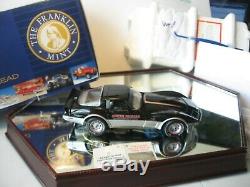
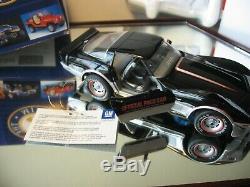
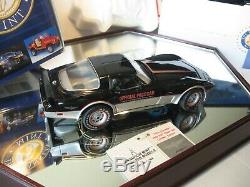
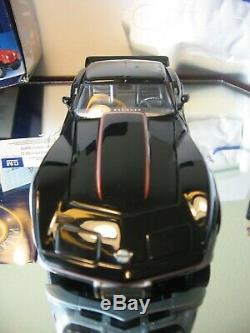
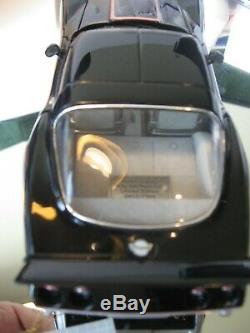
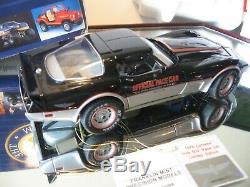
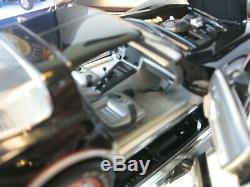
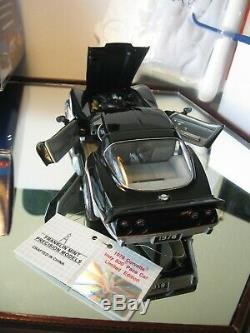
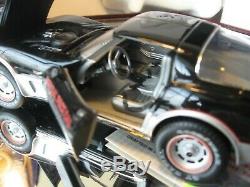
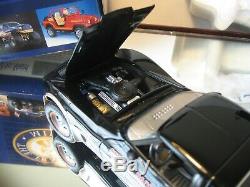
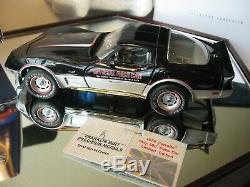


MIB FRANKLIN MINT 1/24 1978 SILVER. 1978 Corvette Coupe-Silver Anniversary edition. 1978 was the Corvette's twenty fifth anniversary, and all 78's featured silver anniversary nose and fuel door emblems. Rear window was the most dramatic and noticeable styling change, giving the ten-year-old C3 Corvette body style. A fresh lease on life.
The fixed-glass fastback benefited both aerodynamics and increased the usable luggage space behind the seats while improving rearward visibility in the bargain. A shade was installed that could be pulled forward to cover the rear compartment to protect cargo and carpet against the unrelenting sun.
The tachometer and speedometer were redesigned to match the new aircraft styled center console and gauge cluster first seen the previous year. Redesigned interior door panels were also new as well as an actual glove box was added in front of the passenger seat, replacing the map pockets of previous years. Available options now included power door locks, a power antenna, dual rear speakers and a CB radio. The optional convenience group, introduced the previous year, now included intermittent (delay) wipers, floor mats, and the passenger side vanity mirror was an upgraded illuminated unit.
The base L-48 engine generated 185 hp (138 kW); Those destined for California or high altitude areas produced 175 hp (130 kW). Gone was the chrome-plated ignition shielding over the distributor, replaced with a metal-lined black plastic unit.The single-snorkel air intake used since 1976 was changed to a dual-snorkel set-up on L-82 equipped cars helping to boost that output to 220 hp (164 kW). L-82 engines were also now fitted with an aluminum intake manifold which saved 24 pounds compared to the cast iron unit of previous years. The Corvette converted to metric tires with the P225/70R15 as standard. Wider P255/60R15 tires were available as an option and required fender trimming from the factory for clearance. The fuel tank capacity increased from 17 gal to 24 gal on all cars.
To make room for the larger tank, a smaller (P195/80D15) space saver spare tire. Two special editions were offered to celebrate Corvette's 25th year. 6502 Indy-500 Pace car replica editions were produced featuring Black/silver two-tone paint, front and rear spoilers, mirror-tint roof panels and contoured sport seats. Reviewers praised the car's classic strengths including its impressive straight-line numbers, especially an L48/automatic's 7.8 second 0-60 time and top speed of 123 mph (198 km/h), and noted its more refined, less rattling ride.
On the other hand, they continued to note its weaknesses, like a rear-end that tended to step out during sharp maneuvers and a cabin that was still cramped and uncomfortable. 1979 saw the crossed-flag emblems on the nose and fuel door revert to the those seen on the'77 model.
Three popular features introduced on the'78 pace car replicas made it into this years production; The new bucket seats, the front and rear spoiler package, and the glass roof panels. The new lightweight high back seats were made standard equipment. The new seats had better side bolster, provided easier access to the rear storage area, and the seat pair resulted in a weight reduction of about 24 pounds. The bolt-on front and rear spoilers were offered as an option and nearly 7,000 cars were ordered so equipped.
Functionally, the spoilers decreased drag by about 15% and increased fuel economy by about a half-mile per gallon. All T-tops were now wired into the standard anti-theft alarm system.
Heavy duty shock absorbers could now be ordered without the full Gymkhana suspension. An auxiliary electric engine cooling fan was first installed, but only on L-82 equipped cars with air conditioning.
Rocker panels and rear window trim were painted black. Output for all engines increased due to new "open flow" mufflers. The dual-snorkel air intake introduced on L-82 cars the previous year was now fitted to all cars and the base engine now generated 195 hp (145 kW). The optional L-82 engine increased to 225 hp (168 kW). This was the final year a manual gearbox could be ordered with the L-82 engine.
This was also the last year for the M21 close-ratio 4-speed, a gearbox that, as in previous years, required the optional L-82 engine. A wide-ratio 4-speed was available for all cars. Noteworthy is that about 82% of the cars were ordered with manual transmissions in 1968. In'79, less than 20% of the cars were delivered with manual gearboxes. This year reached an all-time high in Corvette popularity. Production hit its peak in 1979 at 53,807, a record that stands to this day. Shell only may show wear. In 1927 General Motors hired designer Harley Earl who loved sports cars. GIs returning after serving overseas in the years following World War II. That was made in partnership with the Italian designer Pinin Farina.And British auto engineer Donald Healey. But there were few moderate-priced models. Earl convinced GM that they needed to build a two-seat sports car, and with his Special Projects crew began working on the new car, "Project Opel" in late 1951. The result was the hand-built, EX-122 pre-production Corvette prototype, which was first shown to the public at the 1953 GM Motorama.
Production began six months later. The car is now located at the Kerbeck Corvette museum in Atlantic City.
And is believed to be the oldest Corvette in existence. During the last half of 1953, 300 Corvettes were to large degree hand-built on a makeshift assembly line that was installed in an old truck plant in Flint, Michigan. While a factory was being prepped for a full-scale 1954 production run.
The outer body was made out of then-revolutionary fiberglass. Material, selected in part because quotas, left over from the war, limited the availability of steel.
A 55 degree racked windshield was made of safety glass, while the license plate holder was set back in the trunk, covered with a plastic window. Underneath the new body material were standard components from Chevrolet's regular car line, including the "Blue Flame" inline six-cylinder. Automatic transmission, and drum brakes. The engine's output was increased however from a triple-carburetor system exclusive to the Corvette, but performance of the car was decidedly "lackluster". Compared to the British and Italian sports cars of the day, the Corvette lacked a manual transmission.
And required more effort to bring to a stop, but like their British competition, such as Morgan. Was not fitted with roll-up windows.This would have to wait until sometime in the 1956 model year. Became available in 1954 as a dealer-installed option, greatly improving the Corvette's straight-line performance. But sales continued to decline. The Chevrolet division was GM's entry-level marque. Managers at GM were seriously considering shelving the project.
Leaving the Corvette to be little more than a footnote in automotive history, and would have done so if not for three important events. The first was the 1955 introduction of Chevrolet's first V8 engine. Late in the model year, the new 195 hp (145 kW). Became available with a three-speed manual transmission, coupled to a 3.55:1 axle ratio, the only one offered.
The engine was fitted with a single 2366S WCFB four-barrel (four-choke) Carter carburetor. The combination turned the "rather anemic Corvette into a credible if not outstanding performer".
The second was the influence of a Russian. In GM's engineering department, Zora Arkus-Duntov. The third factor in the Corvette's survival was Ford. S introduction of the 1955 two-seat Thunderbird.
Which was billed as a "personal luxury car", not a sports car. Even so, the Ford-Chevrolet rivalry in those days demanded GM not appear to back down from the challenge. The original concept for the Corvette emblem incorporated an American flag into the design, but was changed well before production since associating the flag with a product was frowned upon. Don't miss out on your chance to own. This authentic signed CAR comes complete FRANKLIN MINT Authenticity.
This is as authentic as it gets!! GreekmanSports specializes in authentic sports memorabilia from only the most trusted companies! ALL ITEMS GUARANTEED BY GREEKMANSPORTS. The item "MIB FRANKLIN MINT 1/24 1978 SILVER & BLACK ANNIVERSARY CHEVY CORVETTE PACE CAR" is in sale since Thursday, November 7, 2019. This item is in the category "Toys & Hobbies\Diecast & Toy Vehicles\Cars, Trucks & Vans\Vintage Manufacture". The seller is "stevestathas" and is located in Garland, Texas. This item can be shipped to United States, Canada.- Vehicle Make: Chevrolet
- Type: Cars
- Scale: 1:24
- Color: Black GRAY
- Vehicle Type: Car
- Vehicle Year: 1978
- Character Family: Corvette
- Brand: Franklin Mint

